Otherworldy Earthly Places Easily Explained
The world is more than four billion years old; if there’s anything we have learned over this course of time, it’s that some things you just can’t explain. Even after many years of scientific advancement, the more we try to solve some mysteries, the more we drown in our own confusion. The problem is not our approach, but some questions have no answers, and the earlier we accept it, the better it is for us. However, this isn’t the case for every mystery in the world. Some things can actually be explained, and some problems we’re capable of solving. This is why we’ve taken it upon ourselves to offer you an explanation of 45 of the world’s most surreal natural phenomena. Here we go!
1- The Salt Desert
If we told you this dessert, just like a mirror, uniquely reflects an image of itself when it rains, would you believe it? We had a hard time believing it, too, and that’s why it makes our list of surreal natural phenomenona.
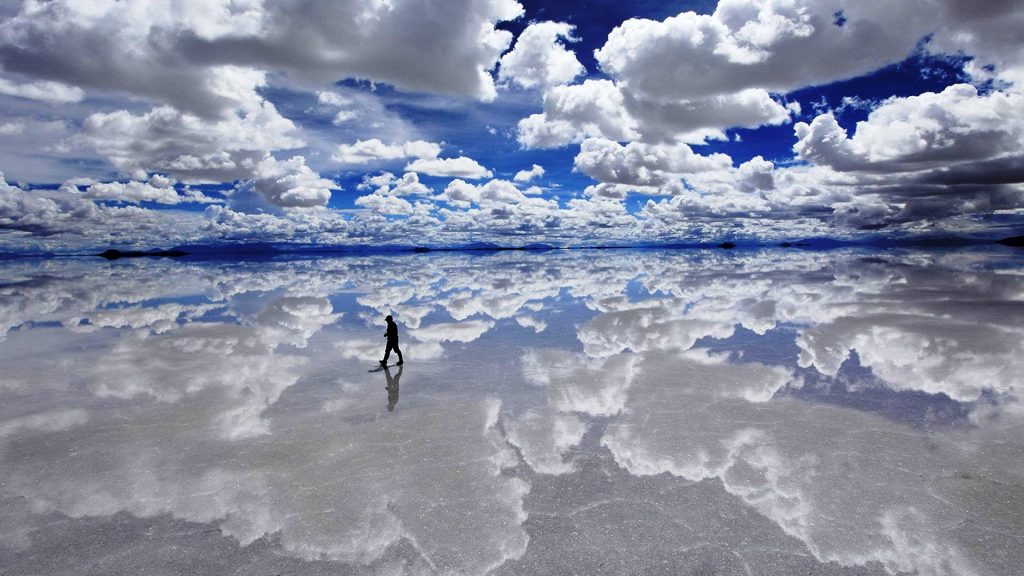
The Salt Desert is the largest flat area on earth, with over 10,000 square kilometers of Inland area. When it rains, a thin layer of the water strangely becomes a reflector showing the desert upside down, just like a mirror.
2- The Volcano with Lightning
This is straight out of the books of Greek mythology and Olympus. If we didn’t know any better, we would say Zeus and Hades have had one of those brotherly battles. However, we assure you that this volcano is real.
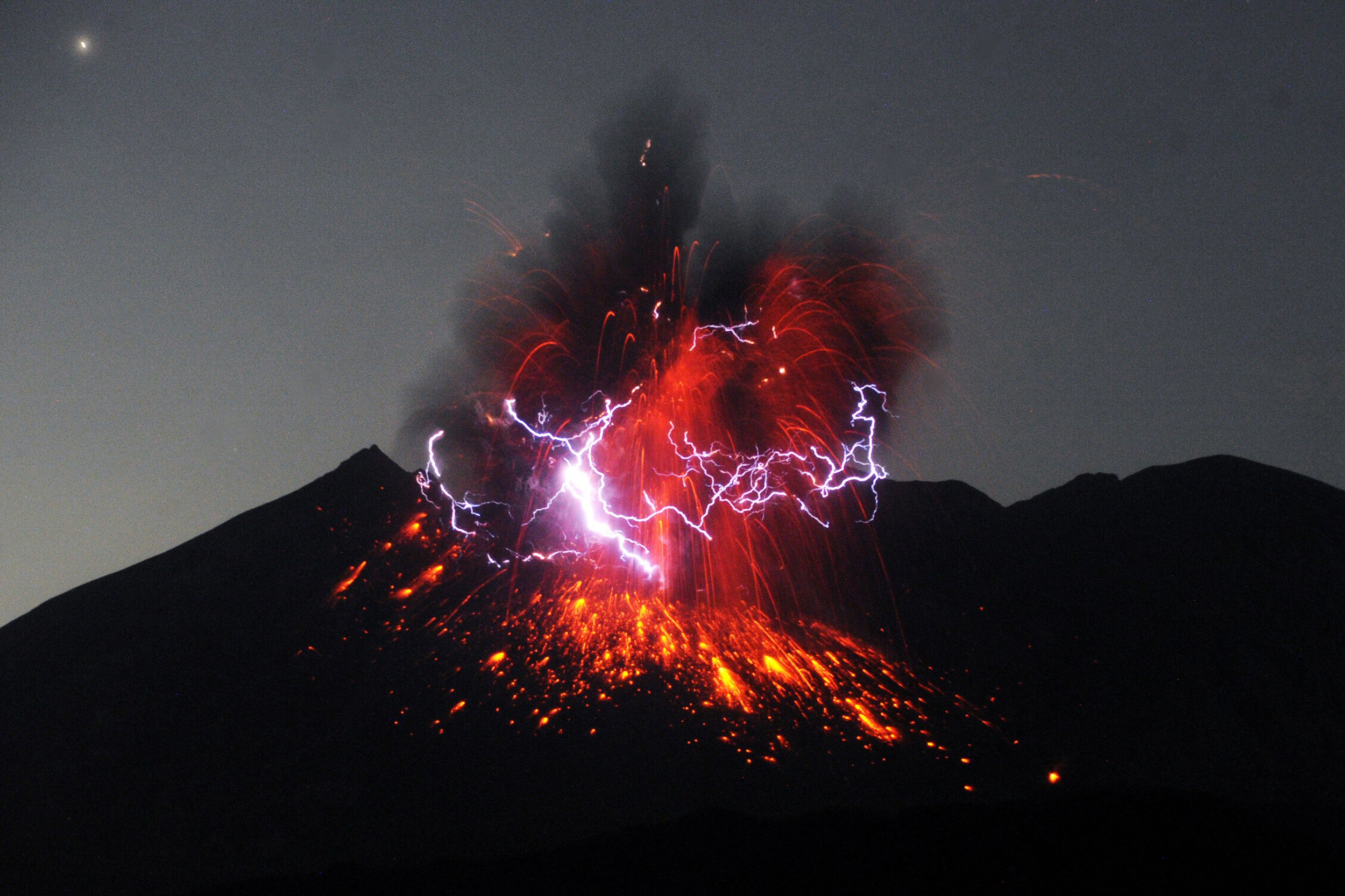
Even though it looks supernatural, we can assure you that it’s not. They call it a “Dirty Thunderstorm,” and the more official and equally cool name is volcanic lightning. It is a rare phenomenon that occurs when erupting volcanoes start emitting lightning due to volcanic ash collisions.
3- The Spider Rain
It may seem like we’re helping Marvel rename their movie, but we’re not. You actually read that right, an actual shower of spiders, here, on earth. Apparently, it’s a common occurrence in a little town in Brazil called “Espirito Santo do Dourado.”
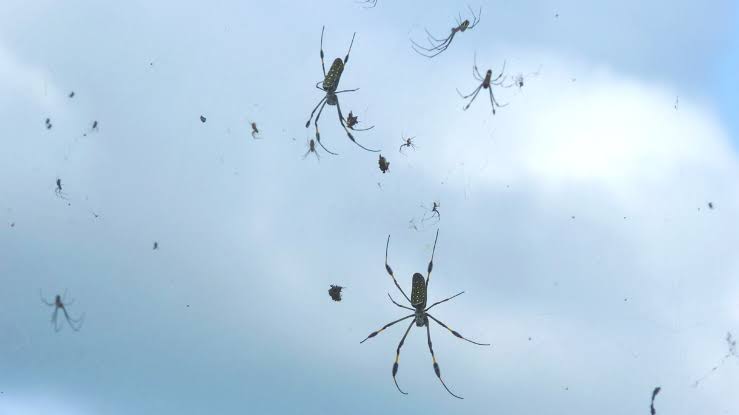
The Spider rain is not a plague; it is simply a natural phenomenon when a species of spiders migrate for food. The competition in the world of spiders can be stiff, and they’re simply trying to survive. may the best arachnid win!
4- The Aurora
In case you see this in the sky, and you’re thinking some type of seal holding back aliens and monsters has been broken, just know it’s because you’ve seen too many movies. What you see here is called an Aurora.
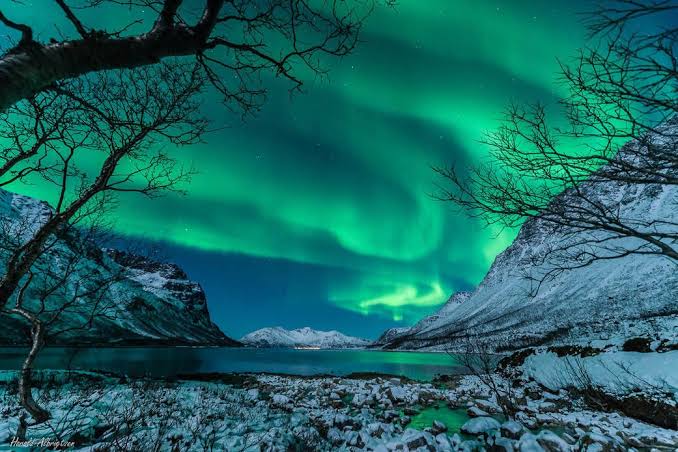
An Aurora is a natural phenomenon that occurs when electrically charged particles from the sun hit different particles like oxygen and nitrogen in the atmosphere. They are wonderful, and their swirl of colors can include green, red, yellow, and even white.
5- The River in a River
An actual underwater river! This just keeps getting weirder and weirder. This underwater pictured here is the Cenote Angelita in Mexico, but it’s not the only place it exists. You’ll find many other rivers like this if you go deep enough.
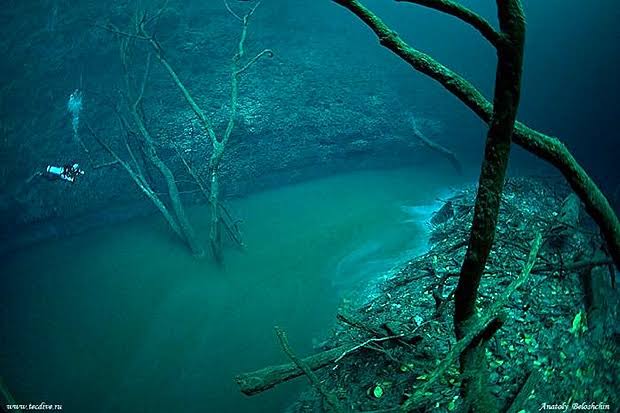
Despite its mystical outlay, the underwater river is simply caused by the presence of too much hydrogen sulfide in the water. In simple terms, it is caused by “halocline” – a milky effect that occurs when freshwater combines with salty groundwater.
6- The Lake with Spots
This lake can be found in Osoyoos, Canada. It is a special lake with features no one had seen before until it was discovered. No one thought a lake could ever have spots, and even if it did, would it look beautiful?
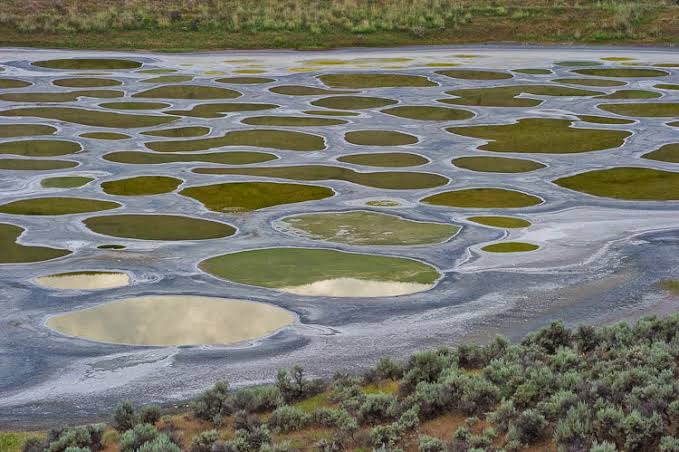
You’ll find this natural phenomenon in the lake when the saline and highly concentrated water evaporates during summer, thereby leaving behind the colorful minerals in the water and popping up the spots in the lake.
7- Frozen Methane Bubbles
Most natural phenomena are either awe-inspiring or strange, but this has to be one of the most beautiful ones you’ll ever see. These little frozen bubbles are formed when organic matters are piled up at the bottom of a water source.

Abraham Lake in Canada is one of the places you’ll find this phenomenon. When the bacteria in the lake are decomposed, methane gas is what you get. When methane gas is frozen in the water, they become these cute little bubbles.
8- The Spherical Boulders
So many people sit on these boulders today and wonder who created these spheres. These boulders were formed from a geological phenomenon called concretion. No one knows in detail when or why it was formed, but they’re neat to see.
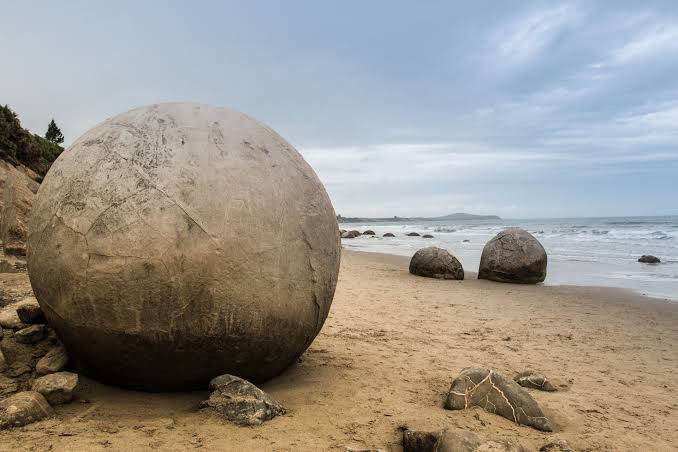
It’s just another gift from Mother Nature, and even though we might not know the whole story, the boulders are harmless. If anything, they make the beach whole. They’re also called the “Moeraki Boulders” and can be found in New Zealand.
9- The Magic Light Waves of Maldives
A wonderful sight. The world wouldn’t mind if all natural phenomenona were this lovely. These bioluminescent water waves can only be found in the Volcano Island of the Maldives. This is a sight we thought only existed in storybooks about magical places.
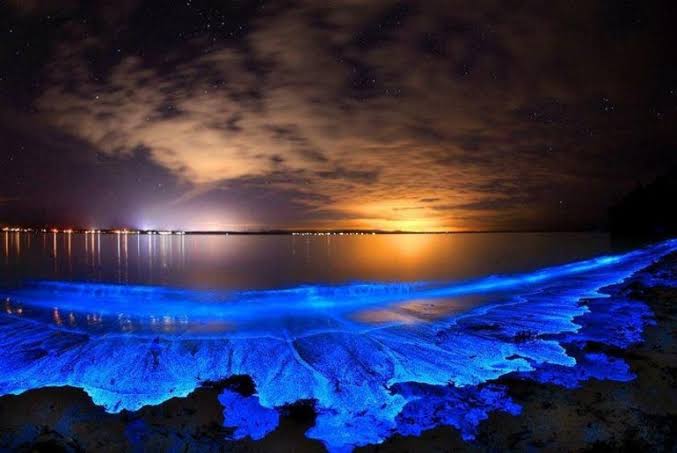
Just like how everything on earth has a scientific and local name, residents call it “The Magic Light.” When the lights emit phytoplankton in the water, the condition of the sea, be it calm or warm, helps the waves glow different colors.
10- The Fairy Circles of Namibia
Whoever named it “The Fairy Circles” really put a lot of thought into that name. Apparently, they thought only a fairy would draw evenly sized and spaced circles that are beautifully surrounded by grasses on a field. We’ll go with it.
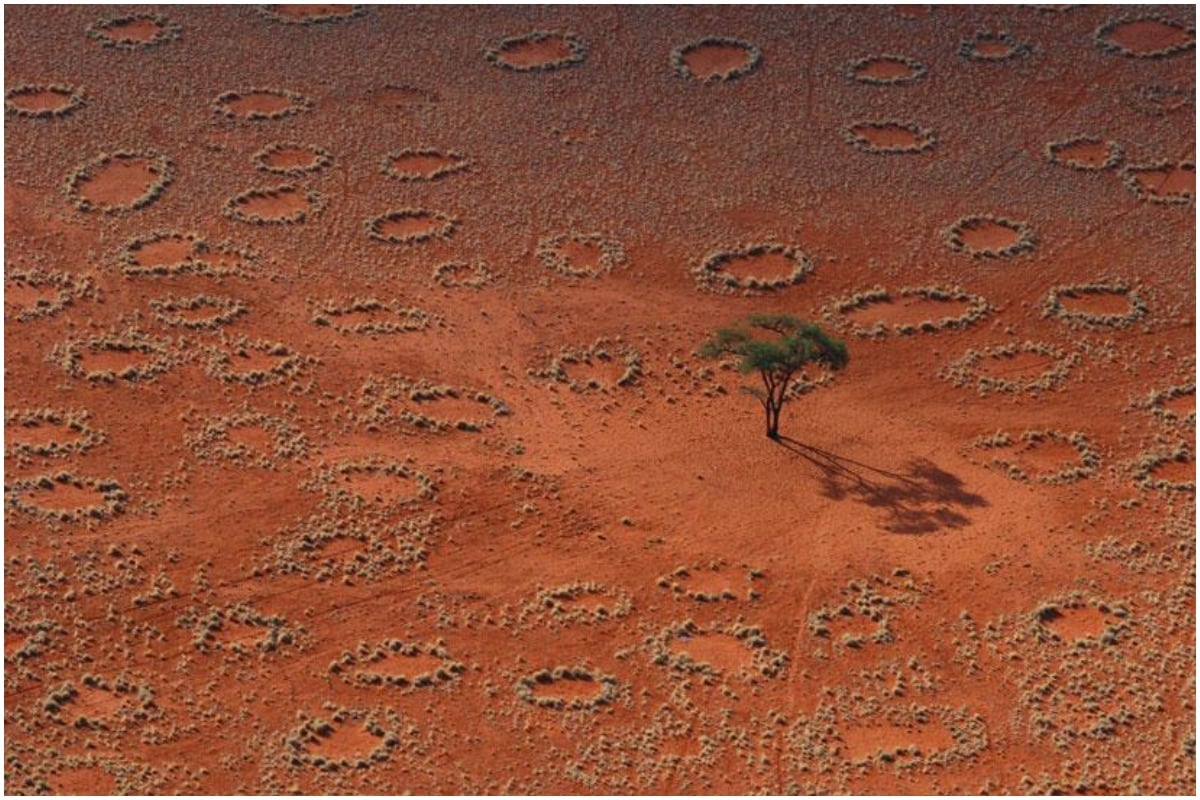
Namibia is a country already famed for its natural heritage and beautiful vast deserts; it makes a lot of sense that it’s also home to the beautiful Fairy Circles. This is one phenomenon on our list without a single agreed-upon scientific reason behind it.
11- The Lenticular Cloud
Sometimes things are not always what they seem, and a good example is the Lenticular Cloud. It is often mistaken for whirlwinds and UFOs when it is actually simply a cloud. This is because of its very peculiar lens shape.
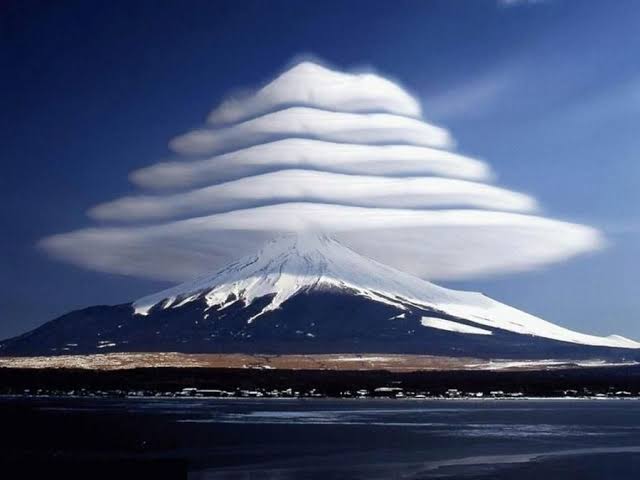
Lenticular Clouds appear when there is a huge instability in the troposphere. That is when moist winds blowing over mountains are caught among the peaks, and they start blowing in perpendicular directions. Sometimes they appear when no clouds are formed.
12- The Snow Chimney
Everything about this phenomenon goes against what we’re used to. This is because chimneys are mostly found in houses and factories, not in the middle of nowhere like an arctic. And chimneys imply fire, not snow. That’s why this is so strange.
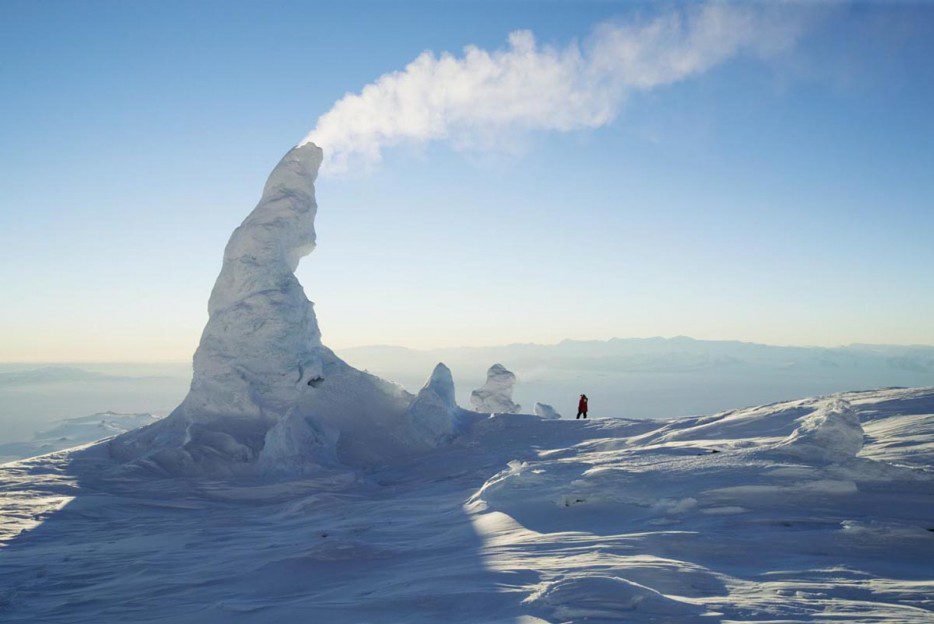
However strange it may be, there is an explanation for it. This mostly happens in volcanic areas or places closer to it. This snow chimney occurs when a volcano opens in colder regions, thereby freezing and creating a chimney-like opening.
13- The Blue Volcano in Ethopia
We won’t say we’re amazed because two common colors of fire we have all seen are blue and red; it doesn’t sound weird for volcanoes to have the same. The only problem is, we’ve never seen or heard of it until this volcano in Ethiopia.
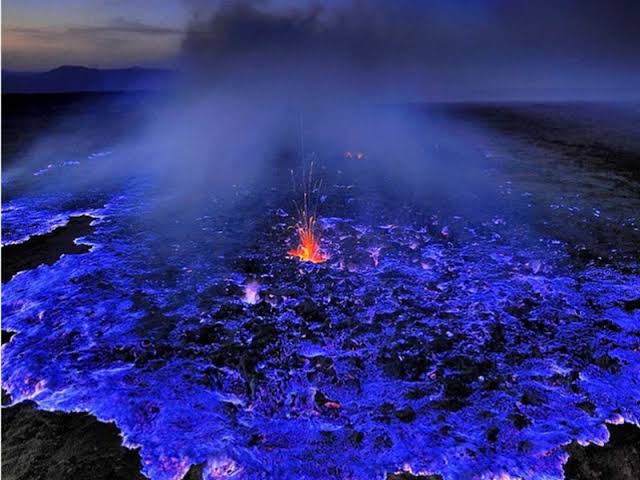
The Blue Volcano is said to result from high sulfur concentration in the volcano, thereby turning its flame and lava blue. It is mostly seen at night and is said to be one of the most complex volcanoes in the world.
14- The Danxia Landforms
To be fair, it looks like the kind of ethereal effect one can see in an impressionist painting. However, this place is real, and you’ll find it in China. It wasn’t always like this, but it became like this due to the erosion of red sandstone.
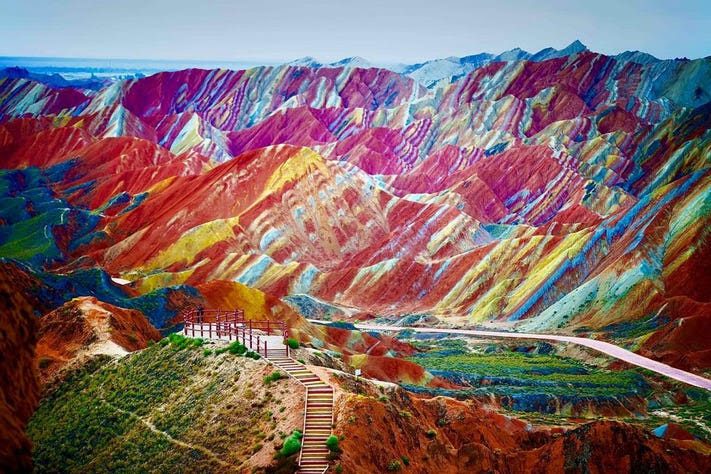
For clarity, we’re simply saying this beautiful mountain was created by wind and water that the long-term desert conditions had influenced. It is a scarce situation that no one could have predicted, and that the exact conditions all came together to create it make it one of a kind.
15- The Great Blue Hole
The rise in sea levels causes the Great Blue Hole off the coast of Belize. It is trendy among divers and is a major attraction for tourists. In 2012, it ranked first in Discovery Channels, The 10 Most Amazing Places on Earth.
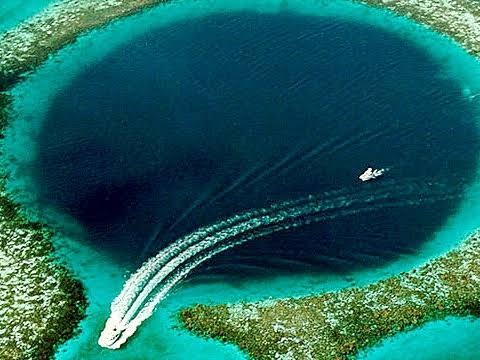
We understand why it won the number one spot. It is 407 feet deep and looks quite incredible. However, it doesn’t change the fact that it is a huge blue hole, and if you ask for our opinion, we’d say swim elsewhere.
16- The Everlasting Storm
Imagine THOR and Zeus having a battle right above our heads. like all lightning storms, the everlasting storm in Venezuela looks like the result of an ongoing duel between the two mythical gods. It never stops, and it seems to carry with it heavy bolts of lightning.
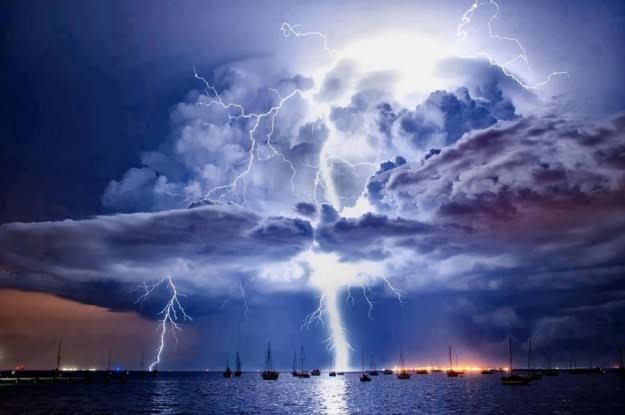
There are reports that the Venezuelan lake could entertain at least a thousand lightning strikes per hour at its peak. And from the Beacon of Maracaibo, one can witness 29 lightning flashes per minute. Bit of advice? Go anywhere but this lake.
17- Ice Caves
Ice caves are natural phenomena found mostly in the arctic and other cold regions. Due to their liquid nature, they don’t last very long and will melt over time. And if you can get over the cold, you’ll find them to be a wonderful place to explore.
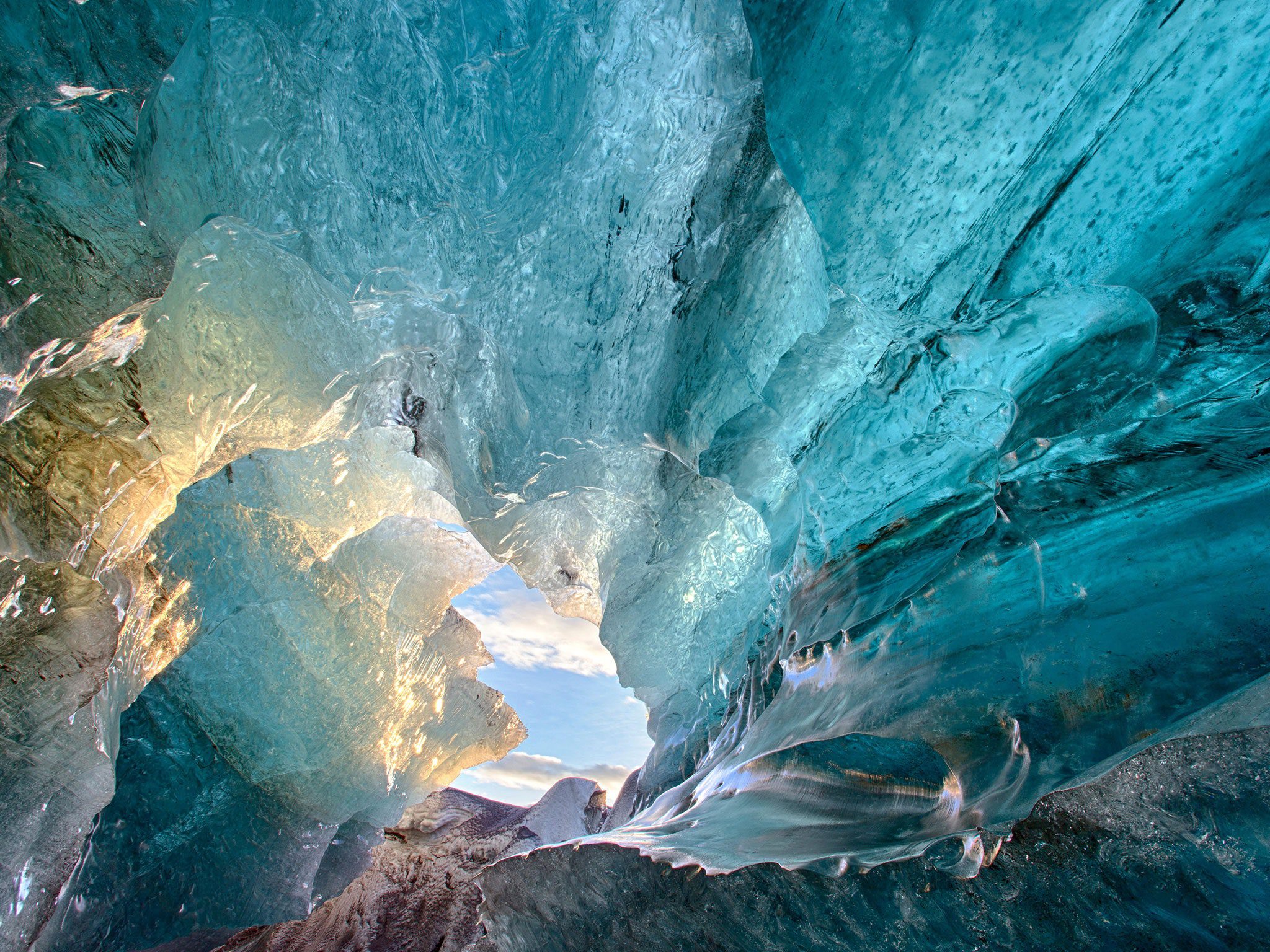
They are formed in a glacier when the glacier cave dissolves and forms lumen or cavities. They can serve as a temporary shelter for winter animals who thrive in the cold. Nothing beats the beautiful scene within an ice cave.
18- Mud Steam
Mud producing steam? Oh, yes! Playing in the mud with a free mind is apparently now a thing of the past as there is now a possibility that you could be boiled alive while playing in said mud. Well, only this kind of mud, really.
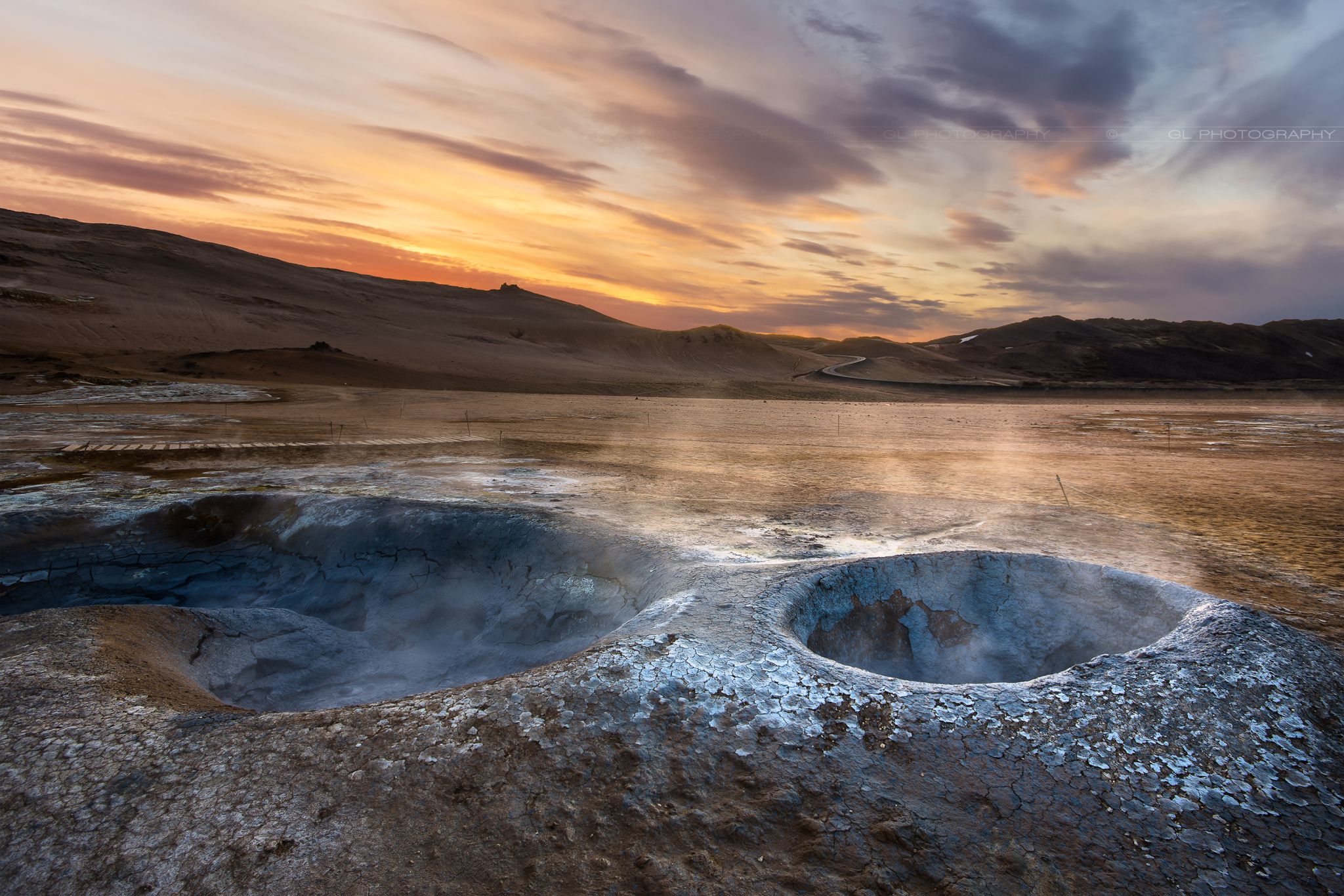
You don’t have to worry too much as this only happens in mud located in Hverir, Iceland. But how does this hot mud spring form? They are caused by geothermal activity from local volcanoes when water flowing underground is heated.
19- Morning Glory Cloud
The Morning Glory Cloud is an infrequent natural phenomenon, one that can scare you out of your wits if you’re seeing it for the first time. They are made up of low-level atmospheric waves with an associated cloud and rare to see.
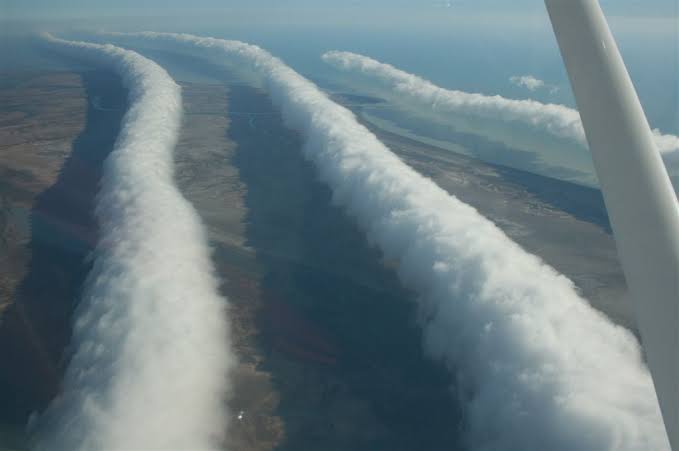
They zoom in, looking like a band of missiles heading to a target location. However, they’re just clouds and are totally harmless. They can be seen in different places at once, but you’re likely to come across them in Burketown, Australia.
20- The Deadly Lake in Tanzania
Some call this lake in Tanzania the Deadly Lake, others call it Lake Natron. Either way, you just know whatever is in there, it isn’t beautiful fish. Deserving of the name “Deadly,” this lake has an unbelievable amount of calcium carbonate.
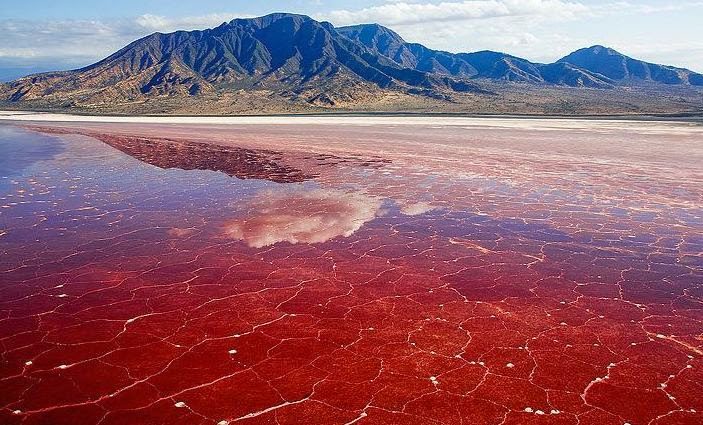
Hence, any small living being that crosses its waters – birds or crocodiles – will be calcified. The scary part is once they’re calcified, they become animal mummies. Unless you’re Dora the Explorer, it’s best if you don’t go anywhere near it.
21- Hell’s Gate in Turkmenistan
This place was formerly a gas reserve, but it is now associated with the opening to hell. This is because it has been 50 years since it was set ablaze by petroleum engineers. Not once, since that time, has it stopped burning.
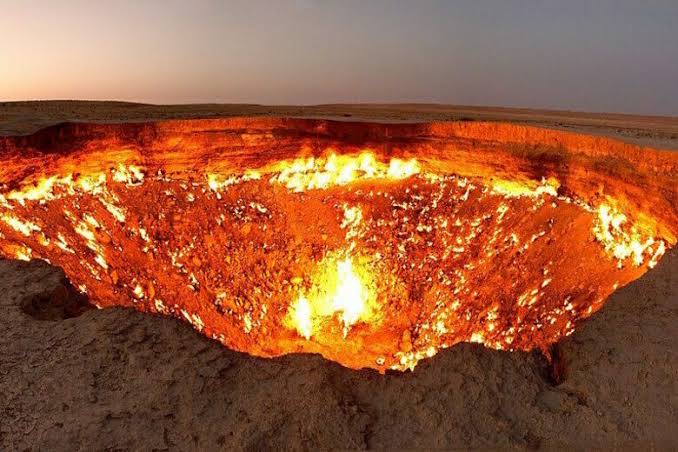
Normally, we don’t believe in hell, but after seeing that such a place exists on earth in Turkmenistan, we’ve decided to rethink our position about its existence. If hell does indeed exist, this has to be one of its man-made gates.
22- The White Rainbow
Rainbows are large multicolored arcs that appear in the sky mostly after heavy rainfall. However, the color white was never known to be a rainbow color until recently. Some call it a fog bow, while others call it the Ghost Rainbow.
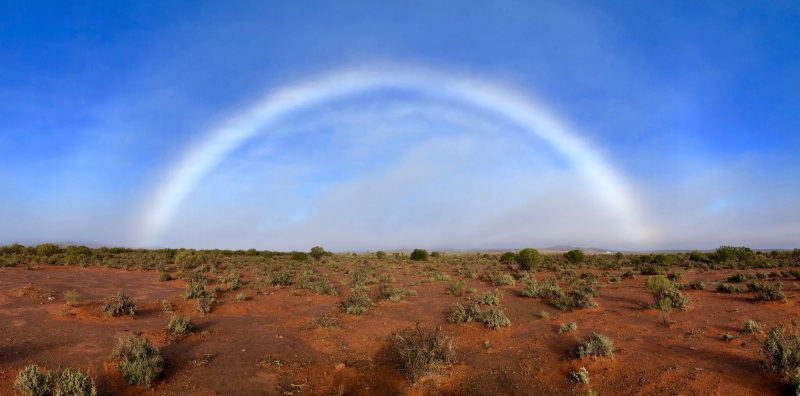
They are the same as regular rainbows; the only difference is, obviously, their color. This rainbow color is white because of the presence of fog droplets. So if you ever see a white Rainbow, it doesn’t mean the world is ending.
23- The Mystery of Underwater Crop Circles
Humans have found it so convenient to blame aliens for the mysteries our beloved science couldn’t explain or solve for so long. Crop circles found underwater in 1955 were one of those mysteries until the truth – which is less fantastical than you’d think – came to light.
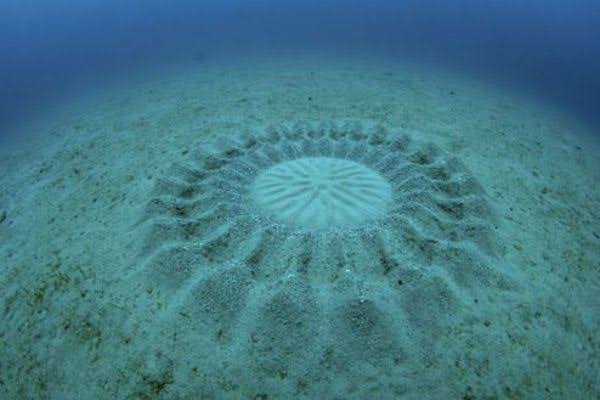
Scientists discovered that a species of fish called the pufferfish was responsible for drawing the crop circles underwater. Apparently, the males make them in order to get the attention of the female pufferfish. Poor aliens; they have been wrongly accused.
24- Mammatus Clouds
Another type of cloud joins the list, and this one has to be the rarest. Once in a while, the shape of the cloud changes to look like a hanging pouch. They call it the Mammatus Cloud, and it usually contains ice.
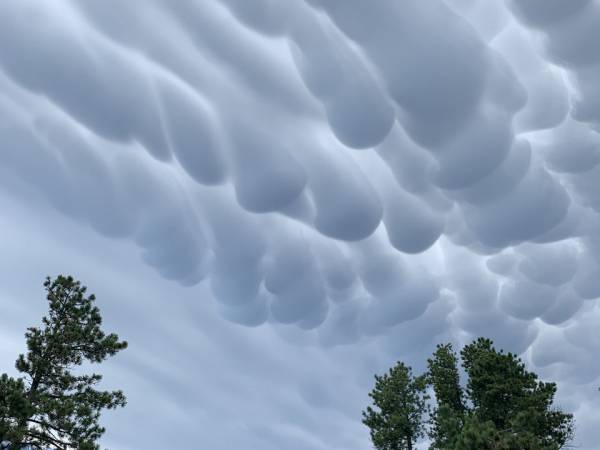
They are huge, created by turbulence, and can cover hundreds of miles while staying visible in the sky for about 10 to 15 minutes. Unless you’re someone who doesn’t pay attention, the Mammatus Cloud is tough to miss when it appears.
25- Maelstrom
Just like you may have seen in hit movies like Percy Jackson and Pirates of the Caribbean, Maelstroms are the most powerful type of whirlpool. They mostly occur in seas and oceans, and of all the Maelstroms, the “Saltstraumen” is the deadliest.
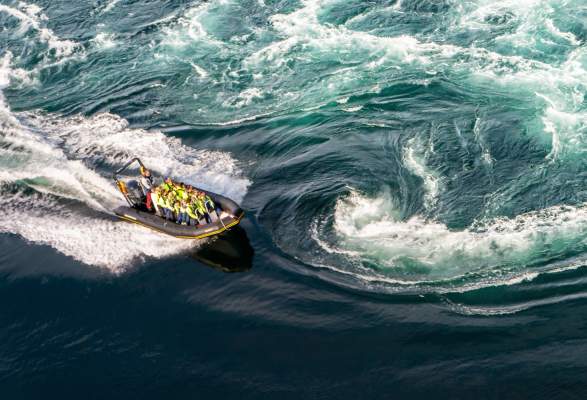
The Salstraumen is the most powerful Maelstrom in the world. It has a water speed of more than 20 knots and over 3000 m3 of water flow. At full force, it can effortlessly suck in human beings, animals, and objects.
26- The Asperatus
The Asperatus or Agitated Cloud is another form of a cloud that is incredibly rare. It was last seen in 2009, and despite the best efforts of many scientists, it still hasn’t resurfaced. No one knows when or where it’ll show up.
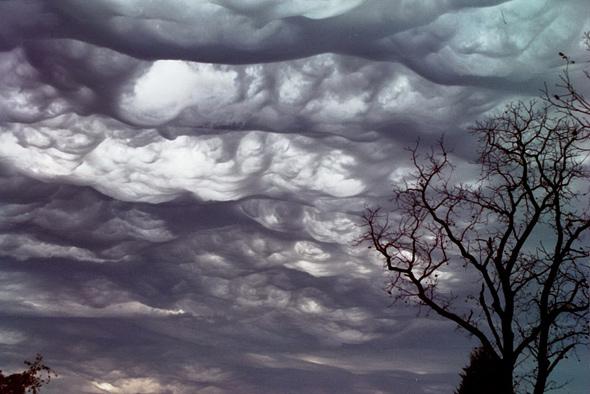
The Asperatus was first founded by Gavin Pretor-Pinney, who was a member of the Cloud Appreciation Society. The Asperatus is a cloud usually formed in a special storm-like formation. The appearance of the Asperatus is said to be very beautiful.
27- Turquoise Ice
The Turquoise Ice was founded in Lake Baikal, a lake that is home to 20% of the world’s freshwater. In this lifetime, you may never get to drink water as clean as the water that can be drawn from this lake.
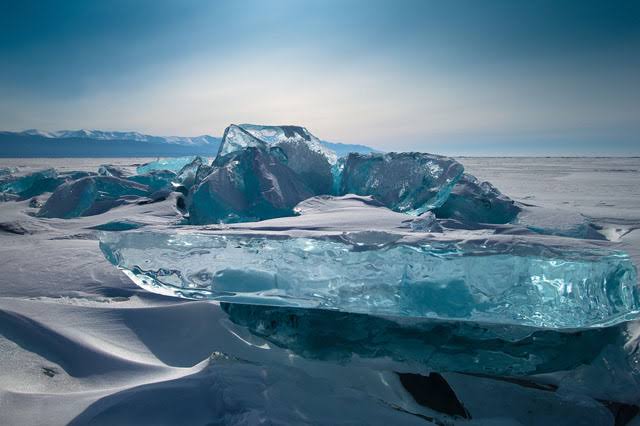
Turquoise Ice surfaces when the lake freezes during winter, and large shards of transparent ice form on its surface, giving it its famous turquoise appearance. When this happens, the landscape becomes breathtakingly beautiful, owing to the calm shade of blue-green.
28- The Striped Icebergs of Antarctica
Even though we’ve seen many beautiful things on this list, it was hard to believe an iceberg could have multiple colors. This is because Antarctica is filled with water and ice blocks, so naturally, the colors of icebergs should be the color of the water.
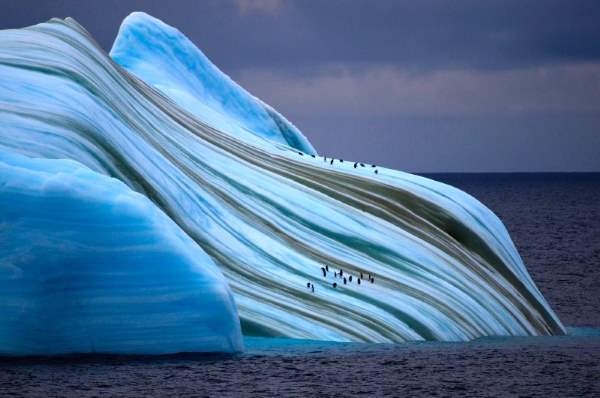
Nonetheless, it is what it is. Some of the Icebergs in Antarctica indeed come in green, blue, brown, and yellow. This is because the layers of ice cannot be predicted, and they sometimes form in special weather and bacterial conditions.
29- Mother of Pearl Cloud
Because of the name, we can imagine how it looks, even if we haven’t seen it before with out own eyes. These prismatic clouds you’re looking at are called the Mother of Pearls. It is a type of cloud mainly seen in polar regions.
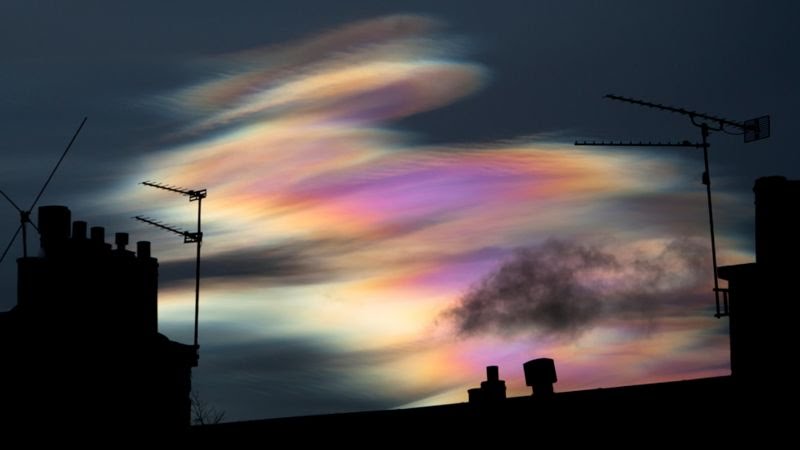
They are best seen at the crack of dawn or right after the sunsets. They are only visible to the eyes during twilight and appear to show multiple colors. They are just like a rainbow but without the arc, and are caused by defracting light through clouds made of ice crystals.
30- The Sun Pillars of Russia
Indeed, every type of weather does have its advantages and disadvantages. While the cold conditions of Russia might be causing one too many problems for some people, it paves the way for the occurrence of the beautiful Sun Pillars of Russia.
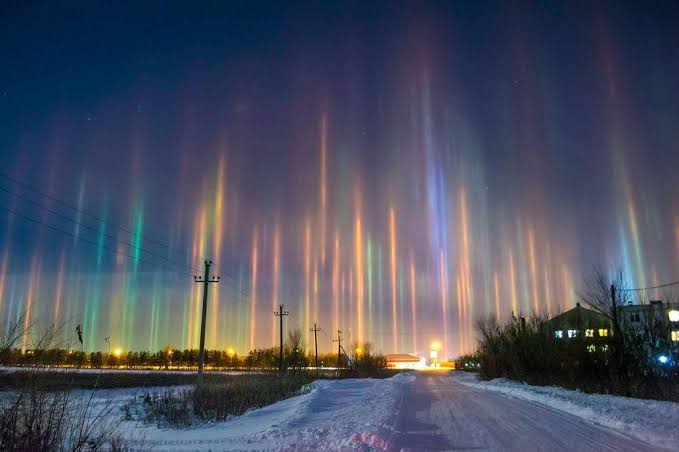
Alternatively known as the Light Pillars, this occurs when the moon reflects against ice crystals, thereby producing different colors of lights. It could happen in the morning during sunrise or in the evening at sundown. Unlike some others on our list, this is not a rare occurance.
31- The Crystal Cave
Buried almost a 1,000 feet underground in Naica, Mexico lies one of the earth’s greatest treasures, the Crystal Cave. This cave is filled with an unimaginable amount of sparkling crystals and was once sought after by chemists and geologists worldwide.
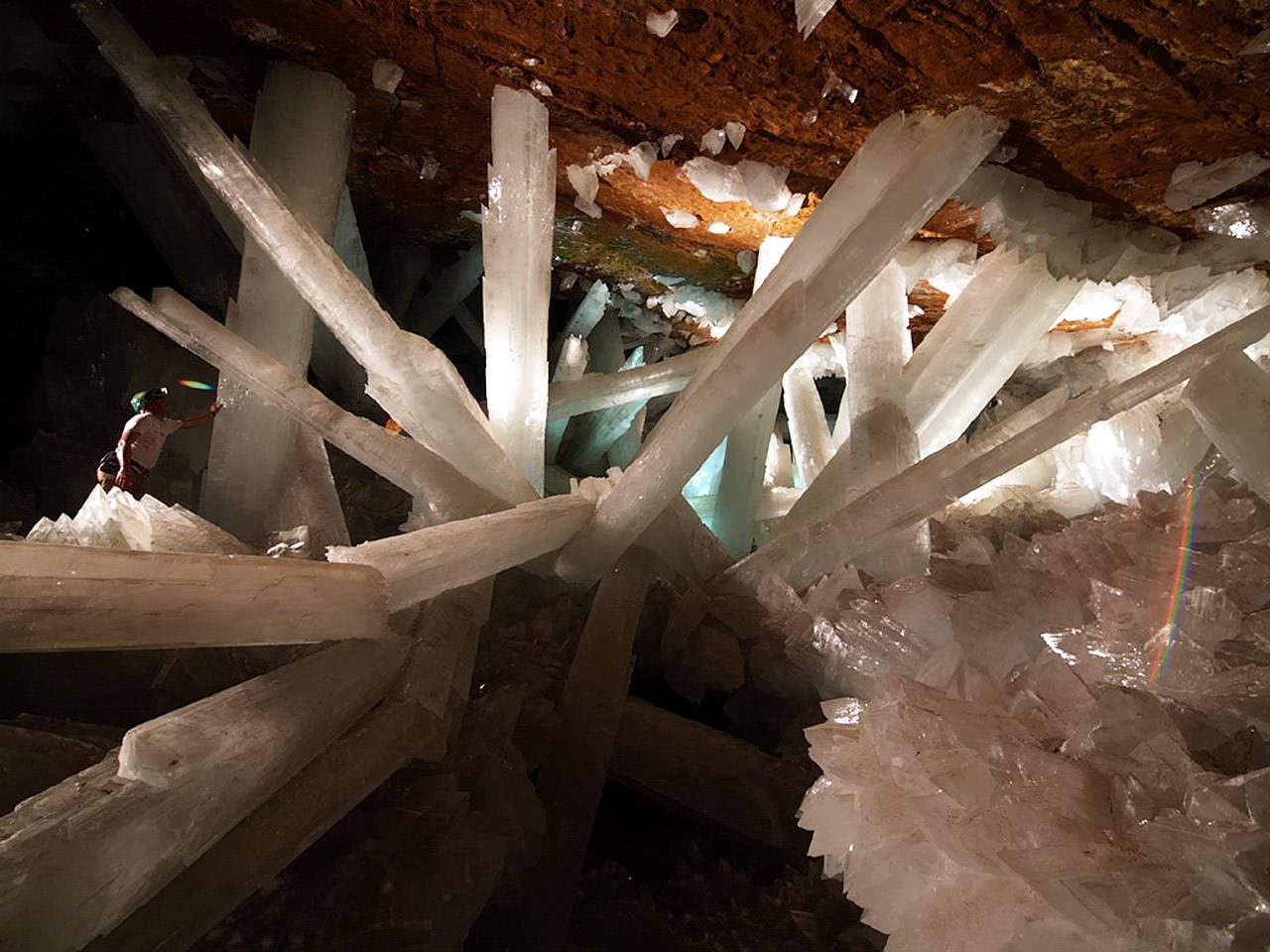
Imagine how rich you would be if you would have an entire cave filled with crystals to yourself. Unfortunately, ever since mining in the cave had stopped, it has been flooded with water and is now closed to tourist visits.
32- The Rainbow Eucalyptus Tree
If we didn’t write the name, we’re sure you would think this was the work of an artist. In a way, you would not have been wrong because this is truly a piece of art. Amazingly, the artist is the rain.
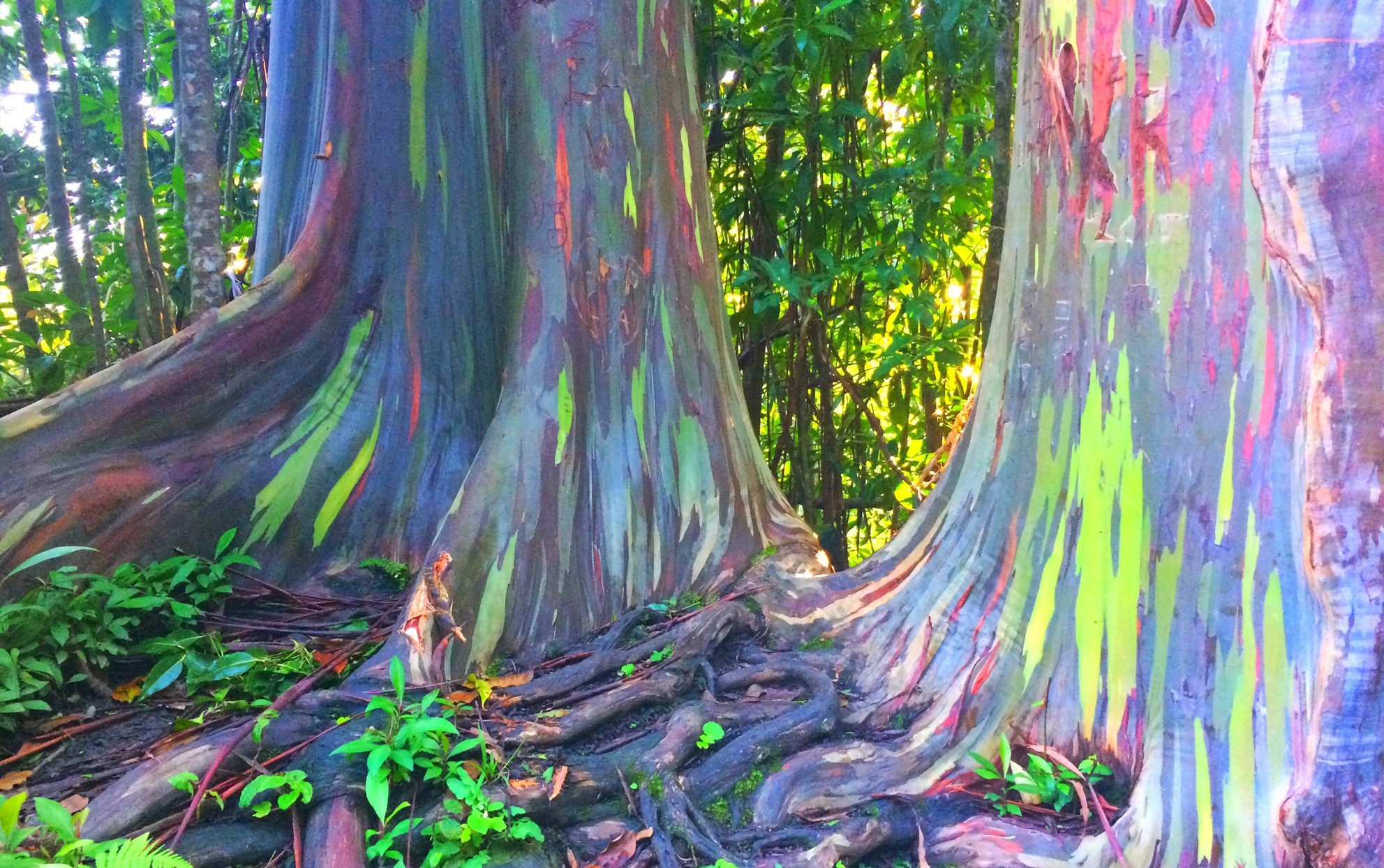
Eucalyptus Trees with multicolored barks can be found in forests that experience heavy rainfalls. You’ll find them in the forests of New Guinea and the Philippines. They usually have multiple colors that include green, purple, blue, orange, and maroon.
33- Supercell Storm
Have you ever seen or experienced a tornado? Whatever you went through would seem like a pinprick if you ever encounter a Supercell Storm. Arguably one of the most dangerous natural phenomena on earth, it is even deadlier than a tornado.
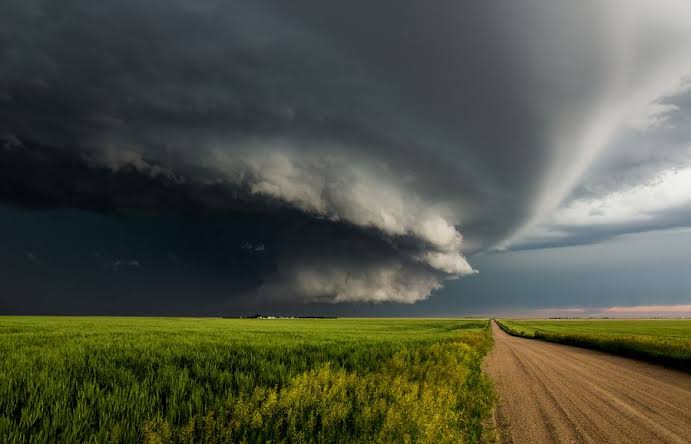
The Supercell Storm can occur anywhere in the world, making these pretty scary. They tend to form in the same areas that tornadoes are found. They are huge and can cause heavy rainfalls, which will lead to flooding and loss of property.
34- The Blue Ice
Ice does not only come in white but also in blue, and other colors. And just like you may have guessed, you’ll find them in very cold places, such as the antarctic. They’re as cold as the regular ice and are only distinct in color.
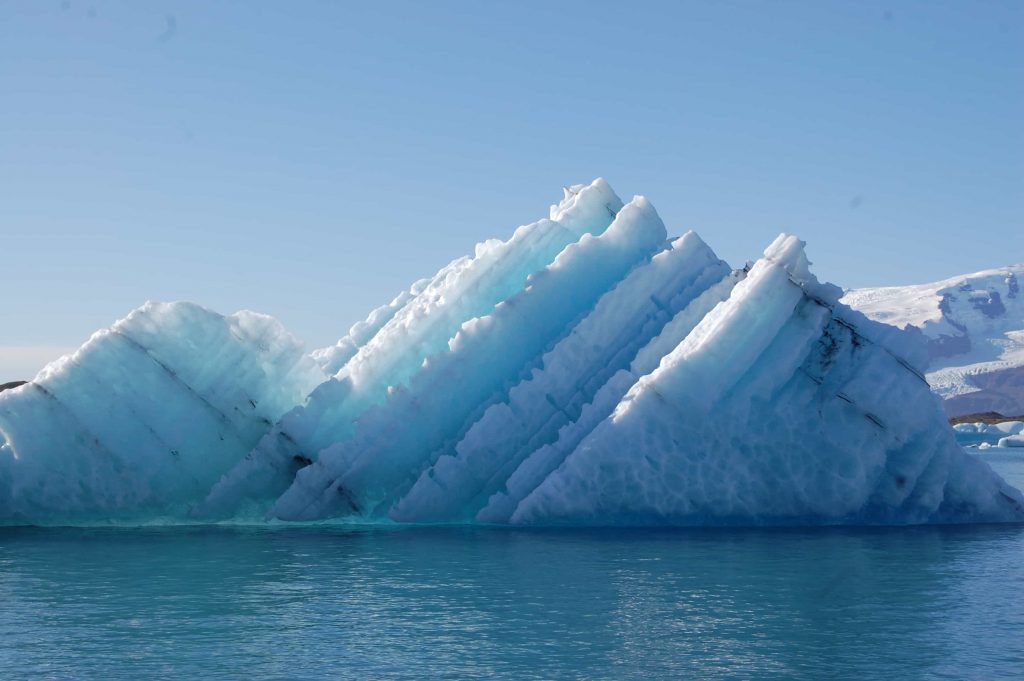
Blue Ice is formed when snow falls on a glacier, gets compressed, and becomes one with it. However, some parts of it will remain white because of air bubbles that form inside them and because water is naturally colorless.
35- The Dragon’s Blood Tree
The Dragon’s Blood Tree is one of the very few natural phenomena on this list that is vulnerable to extinction. They can stay alive for as long as 600 years and can grow to be as high as 30 feet.
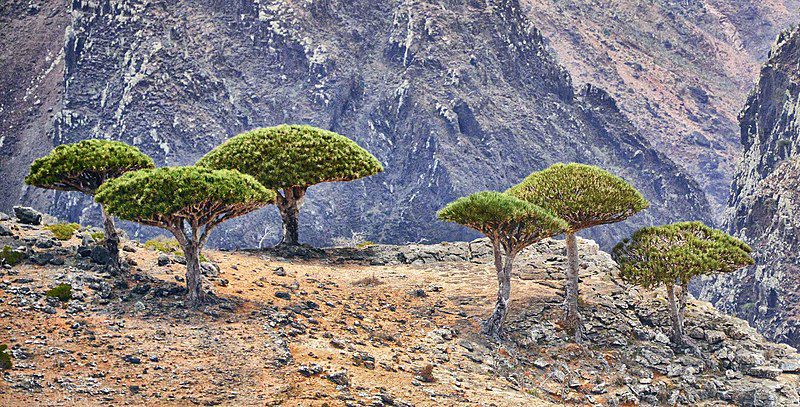
Photo courtesy of Wikipedia Commons/Bff
The Dragon’s Blood Tree is uniquely shaped like an umbrella and can shield multiple people from tsun’s harsh rayssun. It can be found on the island of Socotra Archipelago, just off the coast of Yemen. It is named after the bright red resin (or sap) it produces.
36- Ice Wool
Some call it Ice Wool; others call it Hair Ice. Either way, we can’t be the only ones who think Santa Claus might have used a bit of it for his famous beard. After all, they are very fine and silky.
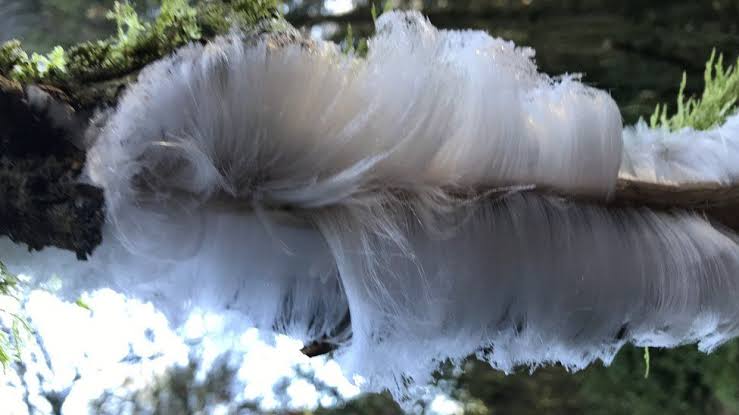
Ice Wool or Hair Ice is a form of ice that occurs on deadwood and is usually found in leaves and small branches. It is scarce, but you might find it in broadleaf forests with Latitudes between 45 and 55 °N.
37- The Migration of Red Crabs
It would appear that humans are not the only ones who travel miles to attend festivities. While roads and airports are the ones that take the heat when we travel, for crabs, it is the roads of Christmas Island in Australia.
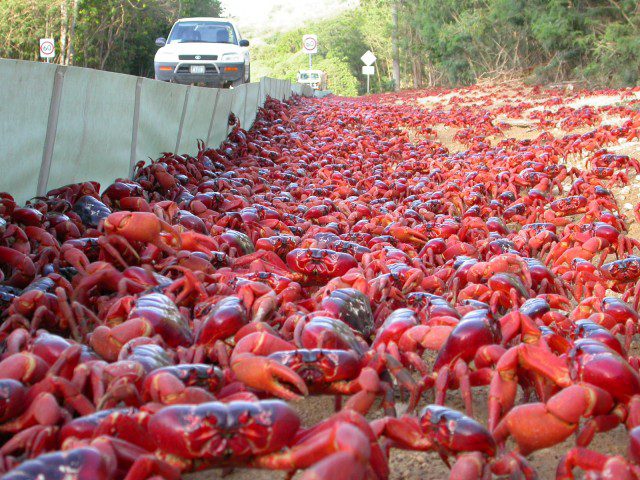
Their event, which is migration, usually takes place in October and November. At that time, you’ll witness long queues of red crabs walking down the roads of Christmas Islands. Be careful not to get in their way, as their claws can be very sharp.
38- The Migration of Monarch Butterflies
It would seem the competition of wildlife is very intense. Just take the monarch butterfly, which is poisonous to its predators. Maybe it’s because they’re called monarchs, or because of their markings, but they are one of the most well-recognized butterfly species.
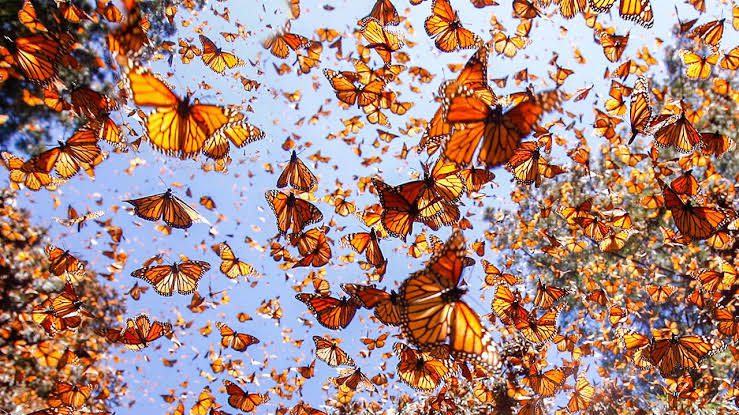
The migration of the Monarch butterflies is a natural phenomenon that happens every Autumn and spring, with over 500,000 monarch butterflies taking part in it. The butterflies spend their entire lives on this journey, and no one butterfly ever makes the entire migration in it’s lifetime.
39- The Frost Flowers of Antarctica
Cold regions that are rife with ice, frost, and unique weather conditions are unsurprisingly home to many strange natural phenomenona. What a flower is doing growing on top of the water is an obvious question anyone would ask at first glance.
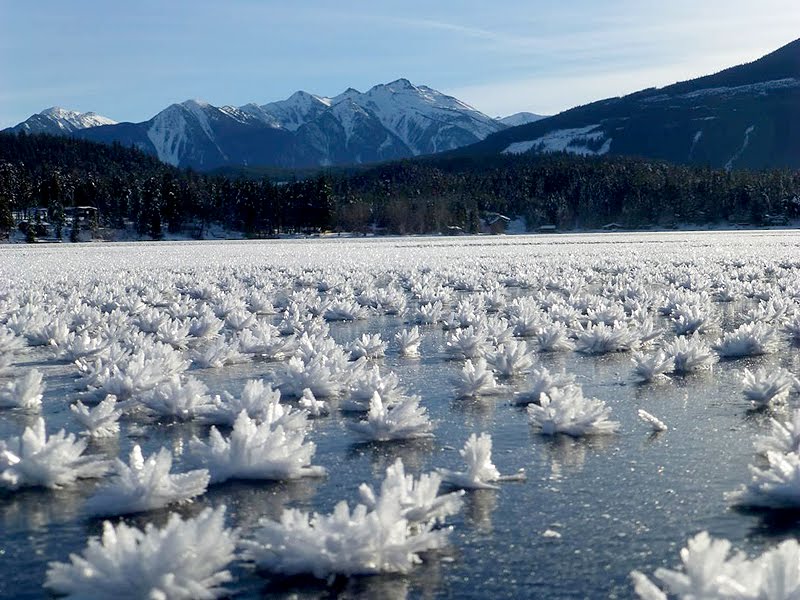
However, even though it looks like it, these are not flowers growing on water. They are shaped like flowers but are, in fact, crystal formations due to the huge decline of the atmospheric temperature. That’s why they are called “Frost Flowers.”
40- The Sardine Run
Just like people in the Olympics, millions of sardines will all come together to swim for one shared goal. Except for this slippery species, they’re not swimming for gold but because they feel threatened. This is how sardines travel and migrate.
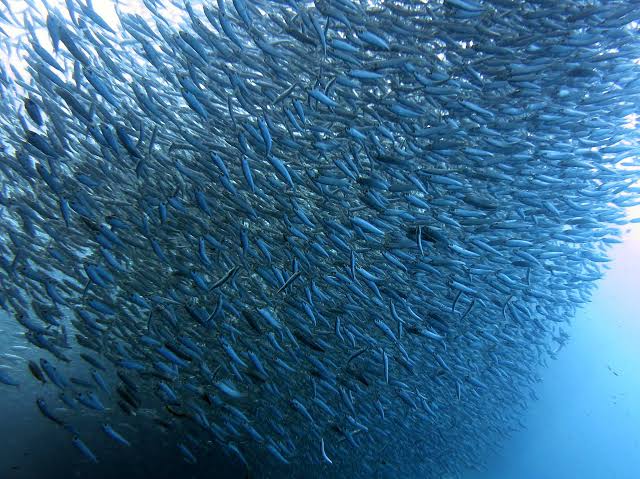
This happens between May and July, and it would see sardines swim from the Agulhas Bank to South Africa. The run begins when the cold water current heads north from the Agulhas Bank to the coasts of Mozambique. It is believed the water temperature causes this migration.
41- The Sailing Stones of Death Valley
Even though there are tracks as if an object or animal moved the stones you see below, it would interest you to know that a living thing does not move them. The force of the wind actually moves the stones.

The Sailing Stones are the remaining particles of ice panels that were melted by the sun and were broken into pieces by the wind. It is a geographical, natural phenomenon, and its tracks can be seen in Death Valley National Park, California.
42- Fire Rainbows
Just because it’s called Fire Rainbow doesn’t mean it’s a rainbow that emits fire. It got the name “Fire Rainbow” because its colors are very similar to a rainbow, but it looks like the flames of a fire. Officially, this optical phenomenon is known as circumhorizontal arc.
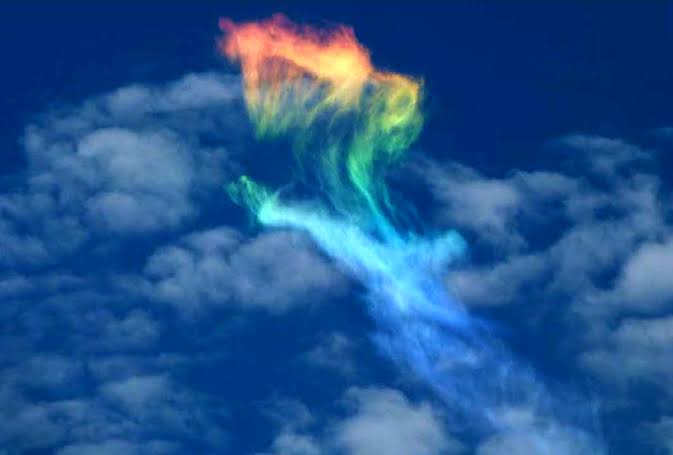
They are caused by lights passing through cirrus clouds floating at a high altitude. They mostly occur when the sun is high in the sky. One was reportedly seen in South Carolina and was said to have remained in the sky for about an hour.
43- The Forest of Knives
Technically, this place is called the Tsingy Forest, and it is located in Madagascar. It is home to a knife-like limestone formation that reaches 230 feet into the air. The only way in and out of this forest is in a helicopter.
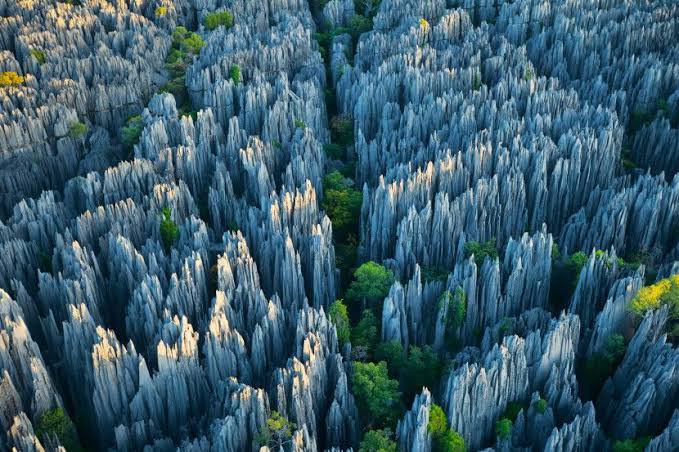
This formation was created by unique erosion patterns. They call it the Forest of Knives because the limestones are razor sharp and can slice just about anything. In other words, you can’t afford to fall because it won’t matter if you’re wearing protective gear.
44- The Eye of the Sahara
They say, “sometimes, to move forward, you need to take a step back.” To uncover this phenomenon, scientists had to leave earth. The Sahara looks like a pile of sand from up close, but from space, it actually has an eye.
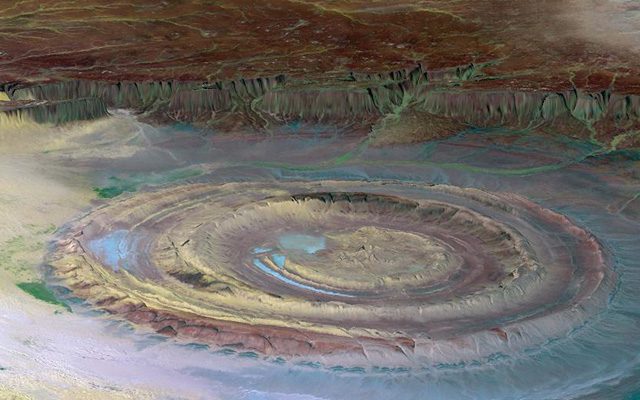
The Sahara desert is the largest hot desert in the world. It’s one of the few places on earth you can’t walk your way out of without proper planning. It was created after a huge volcanic eruption led to the earth collapsing in a symmetrical ring.
45- The Tidal Bore of the Amazon
Also known as “Pororoca,” the Amazon tidal bore is a natural phenomenon that occurs twice a year. Surfers love this phenomenon as it gives them something of a challenge. Unless you’re a surfer, you might not be able to relate.
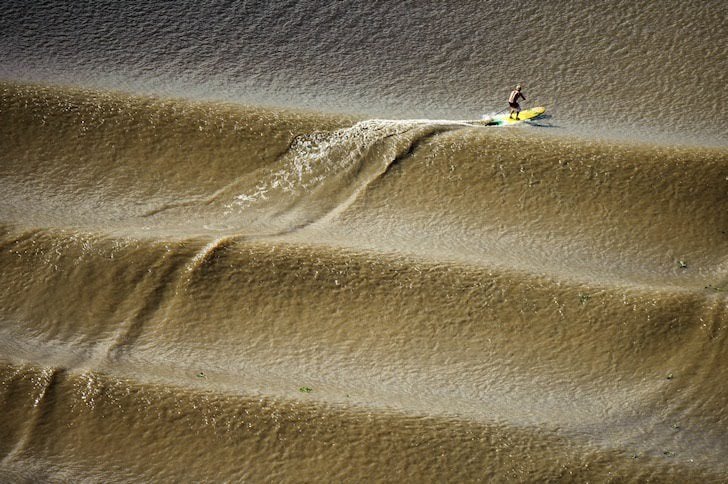
The Pororoca waves are caused by water running against the river’s current. The waves are 13ft high and travel as far as 500 miles on the amazon river. it is probably obvious that the Pororoca can be very dangerous.
